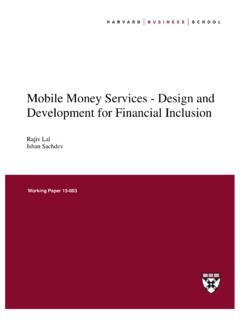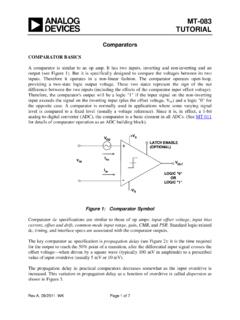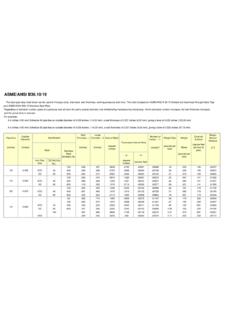Transcription of Guide to Malware Incident Prevention and Handling for ...
1 NIST Special Publication 800-83 Revision 1 Guide to Malware Incident Prevention and Handling for Desktops and Laptops Murugiah Souppaya Karen Scarfone C O M P U T E R S E C U R I T Y NIST Special Publication 800-83 Revision 1 Guide to Malware Incident Prevention and Handling for Desktops and Laptops Murugiah Souppaya Computer Security Division Information Technology Laboratory Karen Scarfone Scarfone Cybersecurity Clifton, VA July 2013 Department of Commerce Cameron F. Kerry, Acting Secretary National Institute of Standards and Technology Patrick D. Gallagher, Under Secretary of Commerce for Standards and Technology and Director ii Authority This publication has been developed by NIST to further its statutory responsibilities under the Federal Information Security Management Act (FISMA), Public Law ( ) 107-347.
2 NIST is responsible for developing information security standards and guidelines, including minimum requirements for Federal information systems, but such standards and guidelines shall not apply to national security systems without the express approval of appropriate Federal officials exercising policy authority over such systems. This guideline is consistent with the requirements of the Office of Management and Budget (OMB) Circular A-130, Section 8b(3), Securing Agency Information Systems, as analyzed in Circular A-130, Appendix IV: Analysis of Key Sections. Supplemental information is provided in Circular A-130, Appendix III, Security of Federal Automated Information Resources.
3 Nothing in this publication should be taken to contradict the standards and guidelines made mandatory and binding on Federal agencies by the Secretary of Commerce under statutory authority. Nor should these guidelines be interpreted as altering or superseding the existing authorities of the Secretary of Commerce, Director of the OMB, or any other Federal official. This publication may be used by nongovernmental organizations on a voluntary basis and is not subject to copyright in the United States. Attribution would, however, be appreciated by NIST. National Institute of Standards and Technology Special Publication 800-83 Revision 1 Natl. Inst. Stand. Technol. Spec. Publ. 800-83r1, 47 pages (July 2013) : NSPUE2 Comments on this publication may be submitted to: National Institute of Standards and Technology Attn: Computer Security Division, Information Technology Laboratory 100 Bureau Drive (Mail Stop 8930) Gaithersburg, MD 20899-8930 Certain commercial entities, equipment, or materials may be identified in this document in order to describe an experimental procedure or concept adequately.
4 Such identification is not intended to imply recommendation or endorsement by NIST, nor is it intended to imply that the entities, materials, or equipment are necessarily the best available for the purpose. There may be references in this publication to other publications currently under development by NIST in accordance with its assigned statutory responsibilities. The information in this publication, including concepts and methodologies, may be used by Federal agencies even before the completion of such companion publications. Thus, until each publication is completed, current requirements, guidelines, and procedures, where they exist, remain operative. For planning and transition purposes, Federal agencies may wish to closely follow the development of these new publications by NIST.
5 Organizations are encouraged to review all draft publications during public comment periods and provide feedback to NIST. All NIST Computer Security Division publications, other than the ones noted above, are available at iii Reports on Computer Systems Technology The Information Technology Laboratory (ITL) at the National Institute of Standards and Technology (NIST) promotes the economy and public welfare by providing technical leadership for the Nation s measurement and standards infrastructure. ITL develops tests, test methods, reference data, proof of concept implementations, and technical analyses to advance the development and productive use of information technology.
6 ITL s responsibilities include the development of management, administrative, technical, and physical standards and guidelines for the cost-effective security and privacy of other than national security-related information in Federal information systems. The Special Publication 800-series reports on ITL s research, guidelines, and outreach efforts in information system security, and its collaborative activities with industry, government, and academic organizations. Abstract Malware , also known as malicious code, refers to a program that is covertly inserted into another program with the intent to destroy data, run destructive or intrusive programs, or otherwise compromise the confidentiality, integrity, or availability of the victim s data, applications, or operating system.
7 Malware is the most common external threat to most hosts, causing widespread damage and disruption and necessitating extensive recovery efforts within most organizations. This publication provides recommendations for improving an organization s Malware Incident Prevention measures. It also gives extensive recommendations for enhancing an organization s existing Incident response capability so that it is better prepared to handle Malware incidents, particularly widespread ones. Keywords Incident response; information security; Malware iv Acknowledgments The authors, Murugiah Souppaya of the National Institute of Standards and Technology (NIST) and Karen Scarfone of Scarfone Cybersecurity, thank their colleagues who assisted with developing this revision of the publication.
8 Acknowledgments, Original Version of SP 800-83 The authors, Peter Mell of the National Institute of Standards and Technology (NIST) and Karen Kent and Joseph Nusbaum of Booz Allen Hamilton, wish to thank their colleagues who reviewed drafts of this document and contributed to its technical content. The authors would particularly like to acknowledge Tim Grance and Murugiah Souppaya of NIST and Lucinda Gagliano, Thomas Goff, and Pius Uzamere of Booz Allen Hamilton for their keen and insightful assistance throughout the development of the document. The authors would also like to express their thanks to security experts Mike Danseglio (Microsoft), Kurt Dillard (Microsoft), Michael Gerdes (Getronics RedSiren Security Solutions), Peter Szor (Symantec), Miles Tracy ( Federal Reserve System), and Lenny Zeltser (Gemini Systems LLC), as well as representatives from the General Accounting Office, and for their particularly valuable comments and suggestions.
9 The National Institute of Standards and Technology would also like to express its appreciation and thanks to the Department of Homeland Security for its sponsorship and support of NIST Special Publication 800-83. Trademark Information All product names are registered trademarks or trademarks of their respective companies. v Table of Contents Executive Summary ..vii 1. Introduction .. 1 Purpose and Scope .. 1 Audience .. 1 Document Structure .. 1 2. Understanding Malware Threats .. 2 Forms of Malware .. 2 Attacker Tools .. 3 The Nature of Today s Malware .. 4 3. Malware Incident Prevention .. 6 Policy .. 6 Awareness .. 7 Vulnerability Mitigation .. 8 Threat Mitigation.
10 10 Antivirus Software ..10 Intrusion Prevention Systems ..12 Firewalls ..13 Content Filtering/Inspection ..13 Application Whitelisting ..14 Defensive Architecture .. 14 BIOS Protection ..14 Sandboxing ..15 Browser Separation ..15 Segregation Through Virtualization ..15 4. Malware Incident Preparation .. 18 Building and Maintaining Malware -Related Skills ..18 Facilitating Communication and Coordination ..18 Acquiring Tools and Resources ..19 Detection and Analysis .. 19 1 Identifying Malware Incident Characteristics ..19 Identifying Infected Hosts ..20 Prioritizing Incident Response ..24 Malware Analysis ..24 Containment .. 25 Containment Through User Participation.

















